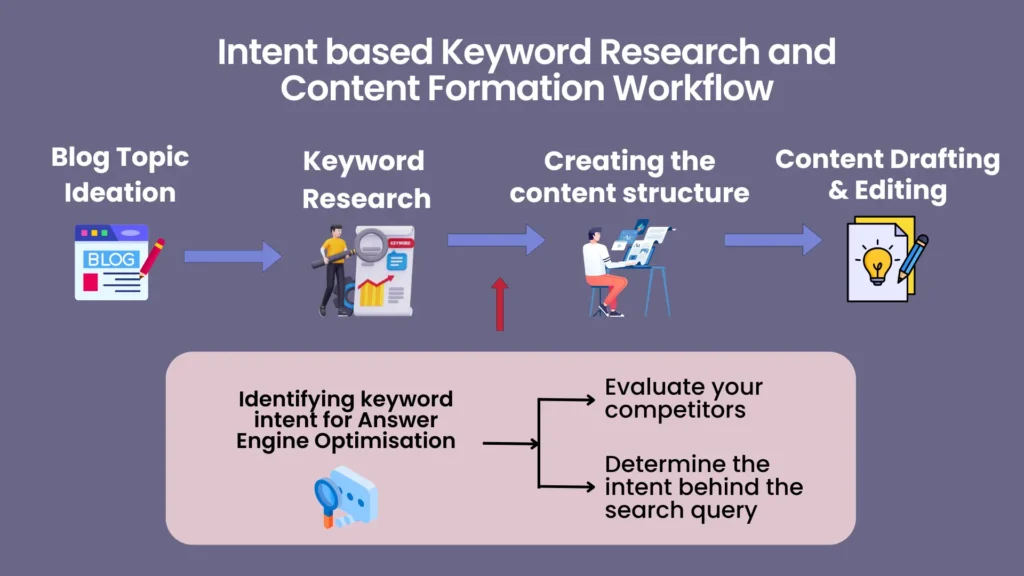For years, search engine optimizers have been familiar with the term keyword research and using the identified keywords in the article to make it rank. While keywords remain a foundational aspect of SEO, the current state of SEO lies in understanding user intent and building topical authority with high-quality content – a concept known as answer engine optimization (AEO).
Keyword research helps a marketer to identify the search terms their target audience is searching for, understanding the keyword intent is now more important to make a page on search engines. A keyword intent carries a message that tells a marketer what type of information a user is searching for when they are researching that particular keyword.
What is Answer Engine Optimization?
Search engines like Google are no longer simply matching keywords; they’re striving to understand the searcher’s intent behind each query they are searching for. This means users are increasingly presented with direct answers to their questions. For Google, this may come as featured snippets, business profile listings, map views, and many more.
You might have realized that when you search something on google, if the answer to your query is based on a quick answer then google will show you the answer directly in a snippet box. Now for a website owner(within the searched niche) to feature on that snippet box they have to understand the intent behind the search term and produce a valuable content piece around it.
Consider a user searching for “best pizza places in Kolkata.” In the past, SEO might have focused on ranking a website with the keyword “pizza Kolkata” multiple times. Today, Google recognizes the user’s intent – finding good pizza – and might display a map snippet with highly-rated pizzerias directly on the search results page based on the location.
This is where AEO comes in. AEO goes beyond keywords to understand the user’s “why” behind the search.
The more you create targeted & intent reach quality content in your niche, the more you portray yourself as an industry expert or subject matter expert in front of your user and Google. This helps you build authority for your website and you will see better traffic due to improved rankings as well.

1. Understand User Intent
Understanding what people are looking for when they type a keyword into a search engine is key to making your website better. When you’re thinking up a new blog post or writing content for a webpage, ask yourself:
- Why are people searching for this?
- What problem do they need solved?
- Who else is showing up in the search results for this term?
- Are those websites really answering the question in the best way?
If you find that the answers out there aren’t quite hitting the mark, then you’ve got a great opportunity. You can aim to provide the exact answers or solutions that people are looking for. Looking at what your competitors are doing is an important part of figuring out what people want to know. Search for the keyword on Google and see where you might do a better job answering the question for your audience.
Even if your competitors have already tackled the question and their website shows up in the search results, take a closer look at how they’ve written their articles. You might find a chance to present the information in a new or better way, helping you stand out to your readers.
Well, an user intent can be broadly categorized into three main types:
- Informational: Users are seeking information to answer a question or learn about a topic. Think “history of Kolkata” or “best time to visit Kolkata.”
- Transactional: Users are looking to take action, such as making a purchase or booking a service. Examples include “buy flights to Kolkata” or “hotels near Kolkata airport.”
- Navigational: Users know exactly where they want to go and are searching for a specific website. This intent is often triggered by brand names like “Wikipedia Kolkata” or “MainLand China Kolkata.”
Once you start doing keyword research you will understand which intent of these 3 does your keyword carries. Based on that you have decided on a content structure that will set the flow for your reader.
Remember, identifying the intent of a keyword is the first step toward AEO. The next important step comes when you have all the ingredients in place and now it is time for you to create the best content on that topic. This brings us to the next step.
2. Building Topical Authority & Relevancy with High-Quality Content
Now that you know how to look for the intent behind the search terms, the next crucial step is to create content that establishes your website as a topical authority. AEO emphasizes the importance of providing high-quality, relevant content that aligns with user intent.
Here’s what this involves:
In-depth content: Simply put, you need to go beyond surface-level information and provide comprehensive, in-depth content that showcases your expertise on the topic. Don’t just skim over the basics; dive deep and offer detailed insights, perspectives, and thorough explanations that truly demonstrate your mastery of the subject matter.
Content variety: To cater to different learning styles and preferences, it’s advisable to use a mix of content formats. In addition to text-based articles, incorporate visuals like images and infographics, and consider using videos as well. Offer a diverse range of content types to your audience. With that you can increase the chances of engaging and resonating with a broader audience.
User-friendly website: Even the best content can fall flat if your website isn’t easy to navigate and user-friendly. Ensure your site is intuitive, visually appealing, and optimized for various devices, including mobile. A positive user experience is crucial for keeping visitors engaged and encouraging them to explore more of your content.
Freshness: To maintain relevance and credibility, it’s essential to regularly update your content with new information and insights. With 7.5 Million blogs published every day, stale or outdated content can quickly become irrelevant. By consistently refreshing your content with the latest developments, trends, and perspectives, you demonstrate your commitment to providing up-to-date and valuable information.
How does AEO help?
Even though the idea of answer engine optimization (AEO) is still evolving, it’s becoming really important for how websites show up on search engines. AEO helps websites not just get their content into the top spot – the featured snippet – but also helps them rank better by focusing on exactly what users are looking for.
Now, with Google’s introduction of Search Generative Experience (SGE), when people search for something, SGE picks out the best answers from websites on that topic. This means users get a direct and clear response to their question right away, along with a link to the website where the answer came from. This way, if they want to know more, they can easily click through to read the full article.
To jot down some points that signifies the benefits of answer engine optimization are –
- Improved search rankings.
- Increased website traffic.
- Better user engagement
- Improved brand awareness and visibility.
Answer Engine Optimization – The Future
We have discussed before that answer engine optimization (AEO) is still a concept that’s shaping up. There are differing opinions among experts. Some believe AEO is about making your content more discoverable by search engines, while others think it’s more about tailoring content for generative and conversational AI tools like ChatGPT and Google Gemini, not to mention optimizing for Ai based voice assistants like Alexa, Siri, and Google Assistant.
There’s some uncertainty about whether AEO fits better with traditional search engines or with the newer conversational AI technologies. However, what’s clear is that the direction of content creation is increasingly geared towards delivering the most accurate answer as quickly as possible to people’s questions.
Search engines are evolving to meet this demand, starting with initiatives like Search Generative Experience (SGE), although the concept of featured snippets has been around for a while. Meanwhile, the emergence of Generative AI (GenAI) has made accessing information much simpler, freeing users from the need to sift through countless links or read through extensive text just to find the answers they seek.
Understanding the intent behind your audience’s searches and why they’re searching is now a cornerstone of any SEO strategy. Whether it’s called AEO or Semantic SEO, the end goal remains the same: to provide what people are looking for in the most straightforward and succinct manner possible.





